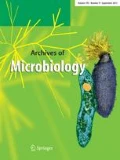Abstract
Two types of new anaerobic bacteria were isolated from anoxic freshwater sediments. They grew in mineral medium with oxalate as sole energy source and with acetate as main carbon source. Oxalate as well as oxamate (after deamination) were decarboxylated to formate with growth yields of 1.2–1.4 g dry cell matter per mol oxalate degraded. No other organic or inorganic substrates were used, and no electron acceptors were reduced. Strain WoOx3 was a Gramnegative, non-sporeforming, motile vibrioid rod with a guanine-plus-cytosine content of the DNA of 51.6 mol%. It resembled the previously described genus Oxalobacter, and is described as a new species, O. vibrioformis. Strain AltOx1 was a Gram-positive, spore-forming, motile rod with a DNA base ratio of 36.3 mol% guanine-plus-cytosine. This isolate is described as a new species of the genus Clostridium, C. oxalicum.
Similar content being viewed by others
References
AllisonMJ, LittedikeET, JamesLF (1977) Changes in ruminal oxalate degradation rates associated with adaptation to oxalate ingestion. J Anim Sci 45: 1173–1179
AllisonMJ, DawsonKA, MayberryWR, FossJG (1985) Oxalobacter formigenes gen. nov., sp. nov.: oxalate-degrading anaerobes that inhabit the gastrointestinal tract. Arch Microbiol 141: 1–7
AnantharamV, AllisonMJ, MaloneyPC (1989) Oxalate: formate exchange: The basis for energy coupling in Oxalobacter. J Biol Chem 264: 7244–7250
BhatJV (1966) Enrichment culture technique. J Sci Ind Res New Delhi 25: 450–454
BlendenDC, GoldbergHS (1965) Silver impregnation stain for Leptospira and flagella. J Bacteriol 89: 899–900
ChandraTS, ShethnaYI (1975) Isolation and characterization of some new oxalate-decomposing bacteria. Antonie van Leeuwenhoek J Microbiol Serol 41: 465–477
ClineJD (1969) Spectrophotometric determination of hydrogen sulfide in natural waters. Limnol Oceanogr 14: 454–458
DawsonKA, AllisonMJ, HartmanPA (1980) Isolation and some characteristics of anaerobic oxalate-degrading bacteria from the rumen. Appl Environ Microbiol 40: 833–839
DehningI, SchinkB (1989) Malonomonas rubra gen. nov. sp. nov., a microaerotolerant anaerobic bacterium growing by decarboxylation of malonate. Arch Microbiol 151: 427–433
DehningI, StiebM, SchinkB (1989) Sporomusa malonica sp. nov., a homoacetogenic bacterium growing by decarboxylation of malonate and succinate. Arch Microbiol 151: 421–426
DeLeyJ (1970) Reexamination of the association between melting point, buoyant density and the chemical base composition of deoxyribonucleic acid. J Bacteriol 101: 738–754
DiekertG, ThauerRK (1978) Carbon monoxide oxidation by Clostridium thermoaceticum and C. formicoaceticum. J Bacteriol 136: 597–606
DiekertG, SchraderE, HarderW (1986) Energetics of CO formation and CO oxidation in cell suspensions of Acetobacterium woodii. Arch Microbiol 144: 386–392
DijkhuizenL, WiersmaM, HarderW (1977) Energy production and growth of Pseudomonas oxalaticus OX1 on oxalate and formate. Arch Microbiol 115: 229–236
HilpertW, SchinkB, DimrothP (1984) Life by a new decarboxylation-dependent energy conservation mechanism with Na+ as coupling ion. EMBO J 3: 1665–1670
HodgkinsonA (1977) Oxalic acid in biology and medicine. Academic Press, Inc, New York
JakobyWB, BhatJV (1958) Microbial metabolism of oxalic acid. Bacteriol Rev 22: 75–80
KrzyckiJA, ZeikusJG (1984) Characterization and purification of carbon monoxide dehydrogenase from Methanosarcina barkeri. J Bacteriol 158: 231–237
LangE, LangH (1972) Spezifische Farbreaktion zum direkten Nachweis der Ameisensäure. Z Anal Chem 260: 8–10
MageeCM, RodeheaverG, EdgertonMT, EdlichRF (1975) A more reliable Gram staining technic for diagnosis of surgical infections. Am J Surg 130: 341–346
MarmurJ (1961) A procedure for the isolation of deoxyribonucleic acid from microorganisms. J Mol Biol 3: 208–218
MorrisMP, Garcia-RiveraJ (1955) The destruction of oxalate by rumen contents of cows. J Dairy Sci 38: 1169
PfennigN, TrüperHG (1981) Isolation of members of the families Chromatiaceae and Chlorobiaceae. In: StarrMP, StolpH, TrüperHG, BalowsA, SchlegelHG (eds) The prokaryotes, vol I. Springer, Berlin Heidelberg New York, pp 279–289
PostgateJR (1963) A strain of Desulfovibrio able to use oxamate. Arch Mikrobiol 46: 287–295
QuayleJR (1961) Metabolism of C1 compounds in autotrophic and heterotrophic microorganisms. Ann Rev Microbiol 15: 119–152
SchinkB, PfennigN (1982) Propionigenium modestum gen. nov. sp. nov., a new strictly anaerobic, nonsporing bacterium growing on succinate. Arch Microbiol 133: 209–216
SmithRL, OremlandRS (1983) Anaerobic oxalate degradation: widespread natural occurrence in aquatic sediments. Appl Environ Microbiol 46: 106–113
SmithRL, StrohmaierFE, OremlandRS (1985) Isolation of anaerobic oxalate-degrading bacteria from freshwater lake sediments. Arch Microbiol 141: 8–13
ThauerRK, JungermannK, DeckerK (1977) Energy conservation of chemotrophic anaerobic bacteria. Bacteriol Rev 41: 100–180
ThimannKV, BonnerWD (1950) Organic acid metabolism. Ann Rev Plant Physiol 1: 75–108
UffenRL (1976) Anaerobic growth of a Rhodopseudomonas species in the dark with carbon monoxide as sole carbon and energy substrate. Proc Natl Acad Sci USA 73: 3298–3302
WiddelF, PfennigN (1981) Studies on dissimilatory sulfate-reducing bacteria that decompose fatty acids. I. Isolation of a new sulfate-reducer enriched with acetate from saline environments. Description of Desulfobacter postgatei gen. nov. sp. nov. Arch Microbiol 129: 395–400
WiddelF, KohringGW, MayerF (1983) Studies on dissimilatory sulfate-reducing bacteria that decompose fatty acids. III. Characterization of the filamentous gliding Desulfonema limicola gen. nov. sp. nov., and Desulfonema magnum sp. nov. Arch Microbiol 134: 286–294
Author information
Authors and Affiliations
Rights and permissions
About this article
Cite this article
Dehning, I., Schink, B. Two new species of anaerobic oxalate-fermenting bacteria, Oxalobacter vibrioformis sp. nov. and Clostridium oxalicum sp. nov., from sediment samples. Arch. Microbiol. 153, 79–84 (1989). https://doi.org/10.1007/BF00277545
Received:
Accepted:
Issue Date:
DOI: https://doi.org/10.1007/BF00277545



